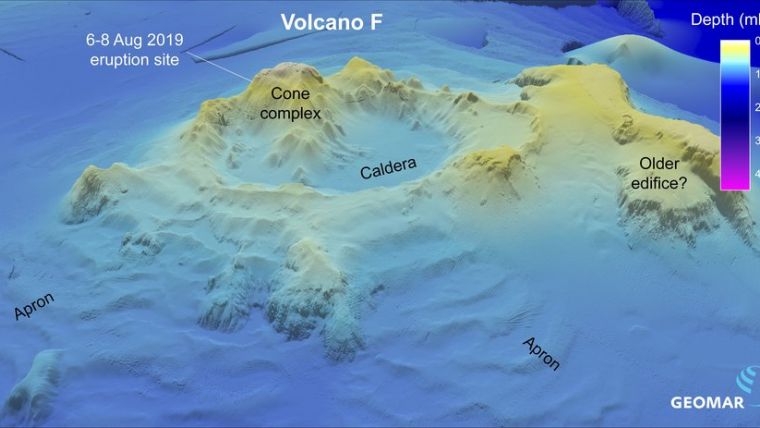Volcano F is the Origin of the Floating Stones, Researchers Discovered
Video Included
Since August, a large accumulation of pumice has been drifting in the Southwest Pacific towards Australia. Researchers at the GEOMAR Helmholtz Centre for Ocean Research Kiel (Germany), together with colleagues from Canada and Australia, have now identified the origin of this pumice raft. It is a so-far nameless underwater volcano in Tongan waters. The study has been published online in the International Journal of Volcanology and Geothermal Research.
Some volcanic eruptions produce a very porous type of rock with a density so low that it floats: pumice. An unusually large amount of it is currently drifting in the Southwest Pacific towards Australia. When it was first sighted in the waters of the island state of Tonga at the beginning of August, it almost formed a coherent layer on the ocean’s surface. The 'pumice raft' made it into headlines all over the world.
Volcano F
Various underwater volcanoes were discussed at that time as the potential source. But direct proof of the exact origin of the pumice was missing up until now. Researchers are now publishing evidence that clearly identifies the culprit. It is a so-far nameless underwater volcano just 50 kilometres northwest of the Tongan island of Vava'u. “In international scientific literature, it appears only under the number 243091 or as Volcano F", says Dr. Philipp Brandl of GEOMAR, first author of the study.
Only in January of this year, Dr. Brandl and several of his co-authors were working in the region on the German research vessel Sonne. The expedition, named Archimedes, aimed to study the formation of new crust in the geologically extremely dynamic region between Fiji and Tonga. “When I then saw the reports on the pumice raft in the media in the summer, I became curious and started researching with my colleagues,” says the geologist.
ESA Satellite Copernicus Sentinel-2
The team found what they were looking for on a freely accessible satellite image. On an image of the ESA satellite Copernicus Sentinel-2 taken on 6 August 2019, clear traces of an active underwater eruption could be seen on the water surface. As the images were exactly georeferenced, they could be compared with corresponding bathymetric maps of the seafloor. “The eruption traces fit exactly to Volcano F”, says Dr. Brandl.
To be on the safe side, the researchers also compared this position with information from global seismic network stations that recorded signals from the eruption. “Unfortunately, the density of such stations in the region is very low. There were only two stations that recorded seismic signals of a volcanic eruption. However, their data is consistent with Volcano F as the origin,” says Dr. Brandl.
Volcanic Eruptions
Pumice can form during volcanic eruptions when viscous lava is foamed by volcanic gases such as water vapour and carbon dioxide. This creates so many pores in the cooling rock that its density is lower than that of water. “During an underwater eruption, the probability to generate pumice is particularly high," explains Dr. Brandl.
With the help of additional satellite images, the team traced the drift and dispersal of the pumice raft until mid-August. It slowly drifted west and reached an area of up to 167 square kilometres. This is about twice the size of Manhattan. The team was also able to constrain the magnitude of the underwater eruption. It corresponded to a volcanic eruption index of 2 or 3, which is similar to recent eruptions of Mount Stromboli, for example.
Great Barrier Reef
With the current direction and speed, the pumice raft is expected to hit the Great Barrier Reef off the eastern coast of Australia at the end of January or beginning of February. Biologists, in particular, are eagerly awaiting this event because pumice rafts may play an important role in the dispersion of fauna in the vastness of the Pacific Ocean. The Kiel team of geologists would like to examine samples of the pumice in order to determine the geochemistry of Volcano F more precisely. "Maybe our Australian colleagues will send us a few samples next year," says Dr. Brandl.
Reference:
Brandl, P. A., F. Schmid, N. Augustin, I. Grevemeyer, R. J. Arculus, C. W. Devey, S. Petersen, M. Stewart, H. Kopp & M. D. Hannington (2019): The 6-8 Aug 2019 eruption of ‘Volcano F’ in the Tofua Arc, Tonga. Journal of Volcanology and Geothermal Research, https://doi.org/10.1016/j.jvolgeores.2019.106695
(Photo courtesy














